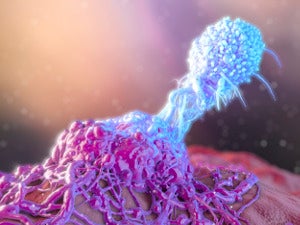LENS Health and Wellness
Inflammation Investigation
Studying How Immune Cells Fight For (and Against) the Human Body
 IMAGE: Maurizio de Angelis/Science Photo Library
IMAGE: Maurizio de Angelis/Science Photo LibraryHuman immune cells battle enemy germs and viruses. But they also can become turncoats that cause inflammation, resulting in serious health issues.
“Too much of anything is good for nothing, and it’s very true of the immune system,” said Pushpa Pandiyan, PhD, an assistant professor in the Case Western Reserve University School of Dental Medicine. Pandiyan investigates white blood cells, called regulatory T-cells (“Tregs”), that help the immune system direct an appropriate response. Her focus: studying the varying—and sometimes contradictory—behaviors of infection-fighting cells.

Pushpa Pandiyan, assistant professor
Pandiyan has shown that boosting or suppressing certain proteins in Tregs can help the cells survive longer and balance optimal immune responses better.
But she’s also found that germs and other body invaders can manipulate Tregs as well—and change them into adversaries that can cause and prolong the very inflammation they were supposed to battle.
And she's discovered ways to tinker with immune responses to reduce inflammation in certain infections or viruses, including HIV. To further that work, she recently began research related to dysfunctional Tregs in people with HIV under a new National Institutes of Health grant that could amount to nearly $1.6 million over five years.
“There are tremendous opportunities in this area of research to improve the quality of life of millions of people,” Pandiyan said.





